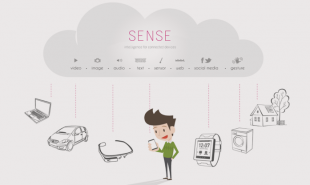
In 2011 we reported on the application IFTTT — If This Then That — when it was little more than an algorithm with vast potential. Lately we are excited to note numerous cutting edge devices powered by IFTTT, such as Smappee, which enable users to program limitless actions within their digital environment — with tangible, real world results. Now, we are seeing Sense, developed by British Cambridge-based startup Neurence, which could become the next building block in the connection between real world objects and online intelligence through highly advanced object-recognition software.
As with IFTTT, Sense is an exciting but unfinished platform — a growing cloud-based brain which will be populated by the input of its users. Essentially it is a Wikipedia of objects — built from programmer and user-inputted audio and image data which is transferred through smart devices. Users can currently contribute to the library using Neurence’s Taggar app. The platform enables users to identify real world objects from books and buildings to pieces of food by simply pointing their device at it. Sense will then present the user with a series of configurable actions — what these are will depend on how app-developers choose to integrate Sense into their software. Potential examples range from simply informing a user about the history of their chosen object to guiding consumers to an ecommerce shop where they could purchase it. A film poster could trigger the video trailer or the local screening times and foreign signs could be translated into the users language. Potentially, individual users will be able to configure their own preferred responses.
Neurence believe they are creating the next generation of search engine — one which doesn’t require reading and writing and can be seamlessly incorporated into the consumers life through smart wearable devices such as Google Glass. They are currently working alongside six device developers including Google and Samsung to experiment with Sense’s potential uses and have recently made it available to any programmers who want to explore Sense’s possibilities while simultaneously helping to populate the library.
You can watch some potential uses of the platform in the video below:
Sense opens up an almost limitless world of possibilities for interaction between the online and offline world. What are the most intriguing potential uses for the platform?
Website: www.neurence.com/
Contact: info@neurence.com




